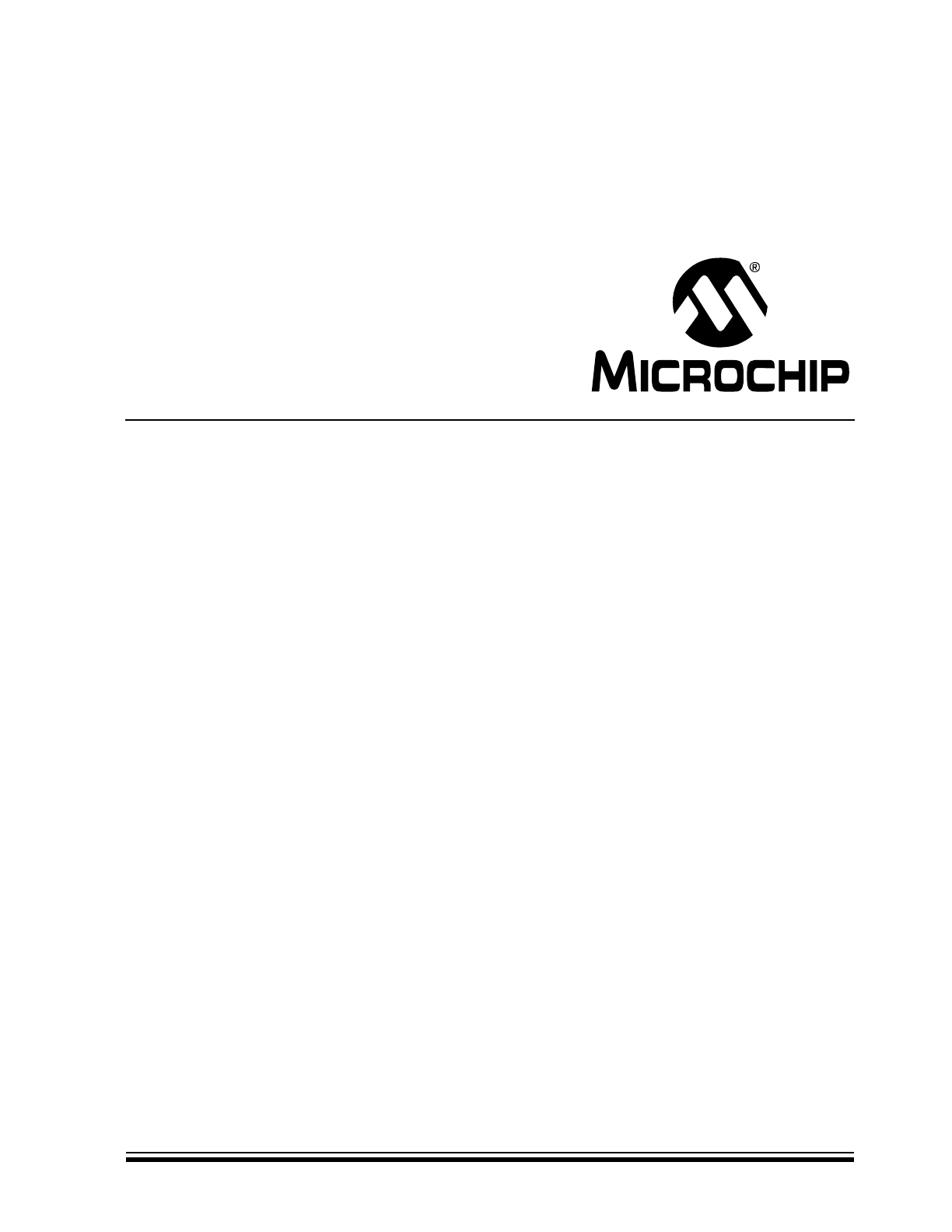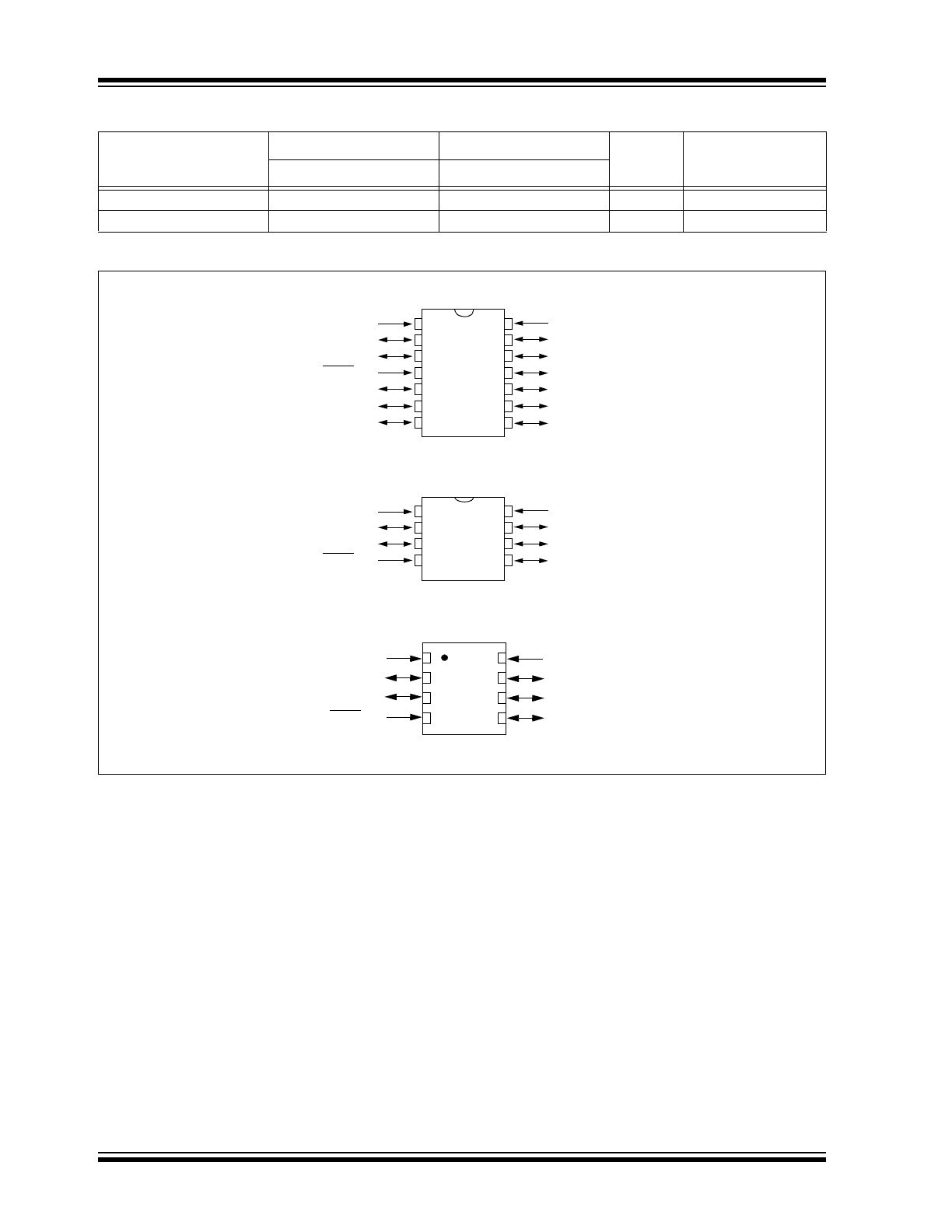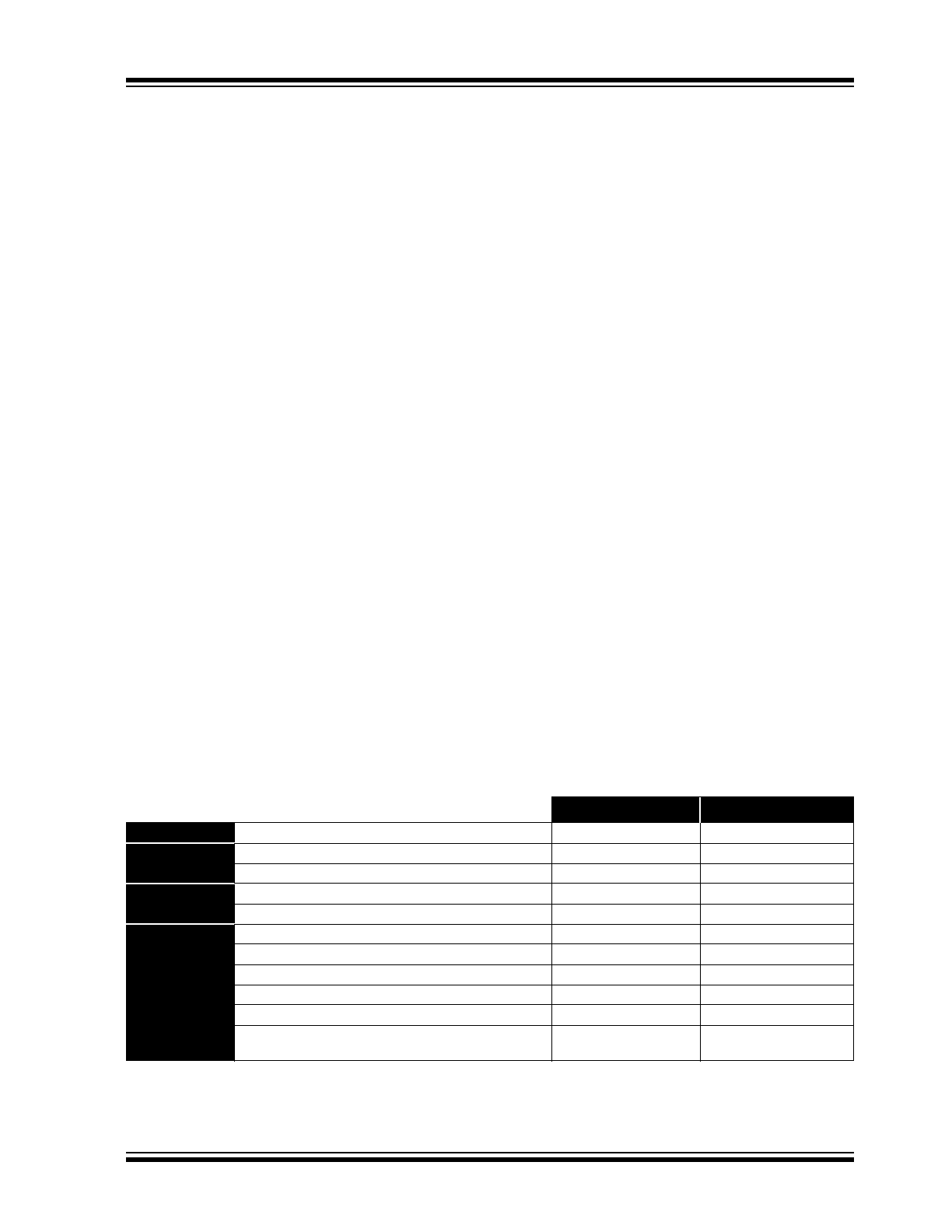
© 2007 Microchip Technology Inc.
DS41268D
PIC12F510/16F506
Data Sheet
8/14-Pin, 8-Bit Flash Microcontrollers

DS41268D-page ii
© 2007 Microchip Technology Inc.
Information contained in this publication regarding device
applications and the like is provided only for your convenience
and may be superseded by updates. It is your responsibility to
ensure that your application meets with your specifications.
MICROCHIP MAKES NO REPRESENTATIONS OR
WARRANTIES OF ANY KIND WHETHER EXPRESS OR
IMPLIED, WRITTEN OR ORAL, STATUTORY OR
OTHERWISE, RELATED TO THE INFORMATION,
INCLUDING BUT NOT LIMITED TO ITS CONDITION,
QUALITY, PERFORMANCE, MERCHANTABILITY OR
FITNESS FOR PURPOSE. Microchip disclaims all liability
arising from this information and its use. Use of Microchip
devices in life support and/or safety applications is entirely at
the buyer’s risk, and the buyer agrees to defend, indemnify and
hold harmless Microchip from any and all damages, claims,
suits, or expenses resulting from such use. No licenses are
conveyed, implicitly or otherwise, under any Microchip
intellectual property rights.
Trademarks
The Microchip name and logo, the Microchip logo, Accuron,
dsPIC, K
EE
L
OQ
, K
EE
L
OQ
logo, microID, MPLAB, PIC,
PICmicro, PICSTART, PRO MATE, rfPIC and SmartShunt are
registered trademarks of Microchip Technology Incorporated
in the U.S.A. and other countries.
AmpLab, FilterLab, Linear Active Thermistor, Migratable
Memory, MXDEV, MXLAB, SEEVAL, SmartSensor and The
Embedded Control Solutions Company are registered
trademarks of Microchip Technology Incorporated in the
U.S.A.
Analog-for-the-Digital Age, Application Maestro, CodeGuard,
dsPICDEM, dsPICDEM.net, dsPICworks, dsSPEAK, ECAN,
ECONOMONITOR, FanSense, FlexROM, fuzzyLAB,
In-Circuit Serial Programming, ICSP, ICEPIC, Mindi, MiWi,
MPASM, MPLAB Certified logo, MPLIB, MPLINK, PICkit,
PICDEM, PICDEM.net, PICLAB, PICtail, PowerCal,
PowerInfo, PowerMate, PowerTool, REAL ICE, rfLAB, Select
Mode, Smart Serial, SmartTel, Total Endurance, UNI/O,
WiperLock and ZENA are trademarks of Microchip
Technology Incorporated in the U.S.A. and other countries.
SQTP is a service mark of Microchip Technology Incorporated
in the U.S.A.
All other trademarks mentioned herein are property of their
respective companies.
© 2007, Microchip Technology Incorporated, Printed in the
U.S.A., All Rights Reserved.
Printed on recycled paper.
Note the following details of the code protection feature on Microchip devices:
•
Microchip products meet the specification contained in their particular Microchip Data Sheet.
•
Microchip believes that its family of products is one of the most secure families of its kind on the market today, when used in the
intended manner and under normal conditions.
•
There are dishonest and possibly illegal methods used to breach the code protection feature. All of these methods, to our
knowledge, require using the Microchip products in a manner outside the operating specifications contained in Microchip’s Data
Sheets. Most likely, the person doing so is engaged in theft of intellectual property.
•
Microchip is willing to work with the customer who is concerned about the integrity of their code.
•
Neither Microchip nor any other semiconductor manufacturer can guarantee the security of their code. Code protection does not
mean that we are guaranteeing the product as “unbreakable.”
Code protection is constantly evolving. We at Microchip are committed to continuously improving the code protection features of our
products. Attempts to break Microchip’s code protection feature may be a violation of the Digital Millennium Copyright Act. If such acts
allow unauthorized access to your software or other copyrighted work, you may have a right to sue for relief under that Act.
Microchip received ISO/TS-16949:2002 certification for its worldwide
headquarters, design and wafer fabrication facilities in Chandler and
Tempe, Arizona; Gresham, Oregon and design centers in California
and India. The Company’s quality system processes and procedures
are for its PIC
®
MCUs and dsPIC
®
DSCs, K
EE
L
OQ
®
code hopping
devices, Serial EEPROMs, microperipherals, nonvolatile memory and
analog products. In addition, Microchip’s quality system for the design
and manufacture of development systems is ISO 9001:2000 certified.

© 2007 Microchip Technology Inc.
DS41268D-page 1
PIC12F510/16F506
Devices Included In This Data Sheet:
• PIC16F506
• PIC12F510
High-Performance RISC CPU:
• Only 33 Single-Word Instructions to Learn
• All Single-Cycle Instructions except for Program
Branches, which are Two-Cycle
• 12-Bit Wide Instructions
• Two-Level Deep Hardware Stack
• Direct, Indirect and Relative Addressing modes
for Data and Instructions
• 8-Bit Wide Data Path
• 10 Special Function Hardware Registers
(PIC12F510)
• 13 Special Function Hardware Registers
(PIC16F506)
• Operating Speed:
- DC – 8 MHz Crystal Oscillator (PIC12F510)
- DC – 500 ns instruction cycle (PIC12F510)
- DC – 20 MHz Crystal Oscillator (PIC16F506)
- DC – 200 ns instruction cycle (PIC16F506)
Special Microcontroller Features:
• 4 or 8 MHz Selectable Precision Internal
Oscillator:
- Factory calibrated to ±1%
• In-Circuit Serial Programming™ (ICSP™)
• In-Circuit Debugging (ICD) Support
• Power-on Reset (POR)
• Device Reset Timer (DRT):
- Short DRT (1.125 ms, typical) for INTOSC,
EXTRC and EC
- DRT (18 ms, typical) for HS, XT and LP
• Watchdog Timer (WDT) with Dedicated On-Chip
RC Oscillator for Reliable Operation
• Programmable Code Protection
• Multiplexed MCLR Input Pin
• Selectable Internal Weak Pull-Ups on I/O Pins
• Power-Saving Sleep mode
• Wake-up from Sleep on Pin Change
• Wake-up from Sleep on Comparator Change
• Selectable Oscillator Options:
- INTOSC: 4/8 MHz precision Internal
oscillator
- EXTRC: External low-cost RC oscillator
- XT: Standard crystal/resonator
- LP: Power-saving, low-frequency crystal
- HS: High-speed crystal/resonator
(PIC16F506 only)
- EC: High-speed external clock input
(PIC16F506 only)
• Analog-to-Digital (A/D) Converter:
- 8-bit resolution
- 4-input channels (1 channel is dedicated to
conversion of the internal 0.6V absolute
voltage reference)
• High Current Sink/Source for Direct LED Drive
• 8-Bit Real-Time Clock/Counter (TMR0) with 8-Bit
Programmable Prescaler
Low-Power Features/CMOS Technology:
• Operating Current:
- < 175
μA @ 2V, 4 MHz, typical
• Standby Current:
- 100 nA @ 2V, typical
• Low-Power, High-Speed Flash Technology:
- 100,000 cycle Flash endurance
- > 40-year retention
• Fully Static Design
• Wide Operating Voltage Range: 2.0V to 5.5V
• Wide Temperature Range:
- Industrial: -40
°C to +85°C
- Extended: -40
°C to +125°C
Peripheral Features (PIC12F510):
• 6 I/O Pins:
- 5 I/O pins with individual direction control
- 1 input only pin
• 1 Analog Comparator with Absolute Reference
Peripheral Features (PIC16F506):
• 12 I/O Pins:
- 11 I/O pins with individual direction control
- 1 input only pin
• 2 Analog Comparators with Absolute Reference
and Programmable Reference
8/14-Pin, 8-Bit Flash Microcontroller

PIC12F510/16F506
DS41268D-page 2
© 2007 Microchip Technology Inc.
Pin Diagrams
Device
Program Memory
Data Memory
I/O
Timers
8-bit
Flash (words)
SRAM (bytes)
PIC16F506
1024
67
12
1
PIC12F510
1024
38
6
1
PDIP, SOIC, MSOP
V
DD
RB5/OSC1/CLKIN
RB4/OSC2/CLKOUT
RB3/MCLR/V
PP
RC5/T0CKI
RC4/C2OUT
RC3
V
SS
RB0/AN0/C1IN+/ICSPDAT
RB1/AN1/C1IN-/ICSPCLK
RB2/AN2/C1OUT
RC0/C2IN+
RC1/C2IN-
RC2/CV
REF
PI
C16F
506
PDIP, SOIC and TSSOP
1
2
3
4
5
6
7
8
9
10
11
12
13
14
V
DD
GP5/OSC1/CLKIN
GP4/OSC2
GP3/MCLR/V
PP
V
SS
GP0/AN0/C1IN+/ICSPDAT
GP1/AN1/C1IN-/ICSPCLK
GP2/AN2/T0CKI/C1OUT
P
IC
12F
510
1
2
3
4
5
6
7
8
DFN
PI
C12F
510
1
2
3
4
8
7
6
5
V
SS
GP0/AN0/C1IN+/ICSPDAT
GP1/AN1/C1IN-/ICSPCLK
GP2/AN2/T0CKI/C1OUTI
V
DD
GP5/OSC1/CLKIN
GP4/OSC2
GP3/MCLR/V
PP

© 2007 Microchip Technology Inc.
DS41268D-page 3
PIC12F510/16F506
Table of Contents
1.0
General Description...................................................................................................................................................................... 5
2.0
PIC12F510/16F506 Device Varieties .......................................................................................................................................... 7
3.0
Architectural Overview ................................................................................................................................................................. 9
4.0
Memory Organization ................................................................................................................................................................. 15
5.0
I/O Port ....................................................................................................................................................................................... 27
6.0
TMR0 Module and TMR0 Register............................................................................................................................................. 39
7.0
Comparator(s) ............................................................................................................................................................................ 43
8.0
Comparator Voltage Reference Module (PIC16F506 only)........................................................................................................ 49
9.0
Analog-to-Digital (A/D) Converter............................................................................................................................................... 51
10.0 Special Features Of The CPU.................................................................................................................................................... 55
11.0 Instruction Set Summary ............................................................................................................................................................ 71
12.0 Development Support................................................................................................................................................................. 79
13.0 Electrical Characteristics ............................................................................................................................................................ 83
14.0 DC and AC Characteristics Graphs and Charts ......................................................................................................................... 97
15.0 Packaging................................................................................................................................................................................. 105
Index .................................................................................................................................................................................................. 117
The Microchip Web Site..................................................................................................................................................................... 119
Customer Change Notification Service .............................................................................................................................................. 119
Customer Support.............................................................................................................................................................................. 119
Reader Response .............................................................................................................................................................................. 120
Product Identification System ............................................................................................................................................................ 121
TO OUR VALUED CUSTOMERS
It is our intention to provide our valued customers with the best documentation possible to ensure successful use of your Microchip
products. To this end, we will continue to improve our publications to better suit your needs. Our publications will be refined and
enhanced as new volumes and updates are introduced.
If you have any questions or comments regarding this publication, please contact the Marketing Communications Department via
E-mail at docerrors@microchip.com or fax the Reader Response Form in the back of this data sheet to (480) 792-4150. We
welcome your feedback.
Most Current Data Sheet
To obtain the most up-to-date version of this data sheet, please register at our Worldwide Web site at:
http://www.microchip.com
You can determine the version of a data sheet by examining its literature number found on the bottom outside corner of any page.
The last character of the literature number is the version number, (e.g., DS30000A is version A of document DS30000).
Errata
An errata sheet, describing minor operational differences from the data sheet and recommended workarounds, may exist for current
devices. As device/documentation issues become known to us, we will publish an errata sheet. The errata will specify the revision
of silicon and revision of document to which it applies.
To determine if an errata sheet exists for a particular device, please check with one of the following:
• Microchip’s Worldwide Web site; http://www.microchip.com
• Your local Microchip sales office (see last page)
When contacting a sales office, please specify which device, revision of silicon and data sheet (include literature number) you are
using.
Customer Notification System
Register on our web site at www.microchip.com to receive the most current information on all of our products.

PIC12F510/16F506
DS41268D-page 4
© 2007 Microchip Technology Inc.
NOTES:

© 2007 Microchip Technology Inc.
DS41268D.-page 5
PIC12F510/16F506
1.0
GENERAL DESCRIPTION
The PIC12F510/16F506 devices from Microchip
Technology are low-cost, high-performance, 8-bit, fully-
static, Flash-based CMOS microcontrollers. They
employ a RISC architecture with only 33 single-word/
single-cycle instructions. All instructions are single-
cycle except for program branches, which take two
cycles. The PIC12F510/16F506 devices deliver
performance in an order of magnitude higher than their
competitors in the same price category. The 12-bit wide
instructions are highly symmetrical, resulting in a
typical 2:1 code compression over other 8-bit
microcontrollers in its class. The easy-to-use and easy-
to-remember instruction set reduces development time
significantly.
The PIC12F510/16F506 products are equipped with
special features that reduce system cost and power
requirements. The Power-on Reset (POR) and
Device Reset Timer (DRT) eliminate the need for
external Reset circuitry. There are four oscillator con-
figurations to choose from (six on the PIC16F506),
including INTOSC Internal Oscillator mode and the
Power-Saving LP (Low-power) Oscillator mode.
Power-Saving Sleep mode, Watchdog Timer and
code protection features improve system cost, power
and reliability.
The PIC12F510/16F506 devices allow the customer to
take full advantage of Microchip’s price leadership in
Flash programmable microcontrollers, while benefiting
from the Flash programmable flexibility.
The PIC12F510/16F506 products are supported by a
full-featured macro assembler, a software simulator, an
in-circuit emulator, a ‘C’ compiler, a low-cost
development programmer and a full featured program-
mer. All the tools are supported on IBM
®
PC and
compatible machines.
1.1
Applications
The PIC12F510/16F506 devices fit in applications
ranging from personal care appliances and security
systems to low-power remote transmitters/receivers.
The Flash technology makes customizing application
programs (transmitter codes, appliance settings,
receiver frequencies, etc.) extremely fast and conve-
nient. The small footprint packages, for through hole or
surface mounting, make these microcontrollers perfect
for applications with space limitations. Low-cost, low-
power, high-performance, ease-of-use and I/O flexibil-
ity make the PIC12F510/16F506 devices very versa-
tile, even in areas where no microcontroller use has
been considered before (e.g., timer functions, logic and
PLDs in larger systems and coprocessor applications).
TABLE 1-1:
PIC12F510/16F506 DEVICES
PIC16F506
PIC12F510
Clock
Maximum Frequency of Operation (MHz)
20
8
Memory
Flash Program Memory (words)
1024
1024
Data Memory (bytes)
67
38
Peripherals
Timer Module(s)
TMR0
TMR0
Wake-up from Sleep on Pin Change
Yes
Yes
Features
I/O Pins
11
5
Input Only Pin
1
1
Internal Pull-ups
Yes
Yes
In-Circuit Serial Programming
Yes
Yes
Number of Instructions
33
33
Packages
14-pin PDIP, SOIC,
TSSOP
8-pin PDIP, SOIC, MSOP,
DFN
The PIC12F510/16F506 devices have Power-on Reset, selectable Watchdog Timer, selectable code-protect, high I/O current
capability and precision internal oscillator.
The PIC12F510/16F506 devices use serial programming with data pin RB0/GP0 and clock pin RB1/GP1.

PIC12F510/16F506
DS41268D.-page 6
© 2007 Microchip Technology Inc.
NOTES:

© 2007 Microchip Technology Inc.
DS41268D-page 7
PIC12F510/16F506
2.0
PIC12F510/16F506 DEVICE
VARIETIES
A variety of packaging options are available. Depend-
ing on application and production requirements, the
proper device option can be selected using the
information in this section. When placing orders, please
use the PIC12F510/16F506 Product Identification
System at the back of this data sheet to specify the
correct part number.
2.1
Quick Turn Programming (QTP)
Devices
Microchip offers a QTP programming service for
factory production orders. This service is made
available for users who choose not to program
medium-to-high quantity units and whose code
patterns have stabilized. The devices are identical to
the Flash devices, but with all Flash locations and fuse
options already programmed by the factory. Certain
code and prototype verification procedures do apply
before production shipments are available. Please
contact your local Microchip Technology sales office for
more details.
2.2
Serialized Quick Turn
Programming
SM
(SQTP
SM
) Devices
Microchip offers a unique programming service, where
a few user-defined locations in each device are
programmed with different serial numbers. The serial
numbers may be random, pseudo-random or
sequential.
Serial programming allows each device to have a
unique number, which can serve as an entry code,
password or ID number.

PIC12F510/16F506
DS41268D-page 8
© 2007 Microchip Technology Inc.
NOTES:
